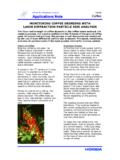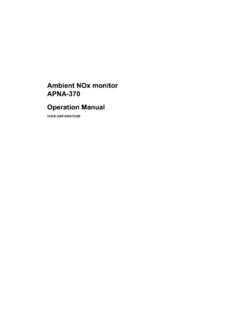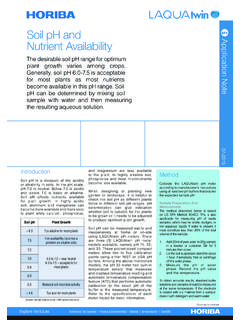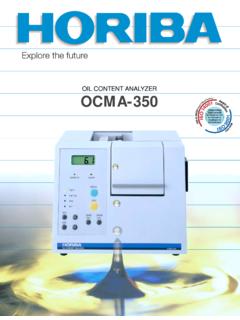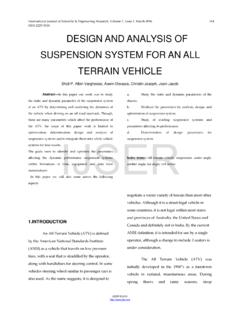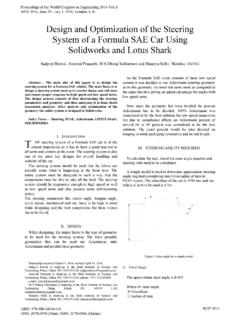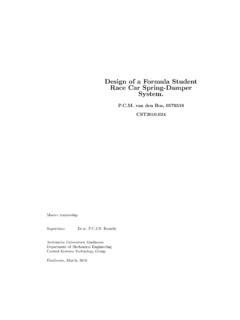Transcription of A GUIDEBOOK TO PARTICLE SIZE ANALYSIS
1 A GUIDEBOOKTO PARTICLE size ANALYSISP article size influences many properties of particulate materials and is a valuable indicator of quality and performance. This is true for powders, suspensions, emulsions, and aerosols. The size and shape of powders influences flow and compaction properties. Larger, more spherical particles will typically flow more easily than smaller or high aspect ratio particles . Smaller particles dissolve more quickly and lead to higher suspension viscosities than larger ones. Smaller droplet sizes and higher surface charge (zeta potential) will typically improve suspension and emulsion stability. Powder or droplets in the range of 2-5 m aerosolize better and will penetrate into lungs deeper than larger sizes. For these and many other reasons it is important to measure and control the PARTICLE size distribution of many in the laboratory are often made to support unit operations tak-ing place in a process environment.
2 The most obvious example is milling (or size reduction by another technology) where the goal of the operation is to reduce PARTICLE size to a desired specification. Many other size reduction operations and technologies also require lab measurements to track changes in PARTICLE size including crushing, homogenization, emulsification, microfluidization, and others. Separation steps such as screening, filtering, cyclones, etc. may be monitored by measuring PARTICLE size before and after the process. PARTICLE size growth may be monitored during operations such as granulation or crystallization. Determining the PARTICLE size of powders requiring mixing is common since materials with similar and narrower distributions are less prone to segregation. There are also industry/application specific reasons why controlling and measuring PARTICLE size is important.
3 In the paint and pigment industries PARTICLE size influences appearance properties including gloss and tinctorial strength. PARTICLE size of the cocoa powder used in chocolate affects color and flavor. The size and shape of the glass beads used in highway paint impacts reflectivity. Cement PARTICLE size influences hydration rate & strength. The size and shape distribution of the metal particles impacts powder behavior during die filling, compaction, and sintering, and therefore influences the physical properties of the parts created. In the pharmaceutical industry the size of active ingredients influences critical characteristics including content uniformity, dissolution and absorption rates. Other industries where PARTICLE size plays an important role include nanotechnology, proteins, cosmetics, polymers, soils, abrasives, fertilizers, and many is PARTICLE size important?
4 PARTICLE size is critical within a vast number of industries. For example, it determines:appearance and gloss of paintflavor of cocoa powderreflectivity of highway painthydration rate & strength of cementproperties of die filling powderabsorption rates of pharmaceuticalsappearances of cosmetics1 TABLE OF CONTENTS 1 Why is PARTICLE size important? Which size to measure 3 Understanding and interpreting PARTICLE size distribution calculations Central values: mean, median, mode Distribution widths Technique dependence Laser diffraction Dynamic light scattering Image ANALYSIS 8 PARTICLE size result interpretation: number vs. volume distributions Transforming results 10 Setting PARTICLE size specifications Distribution basis Distribution points Including a mean value X axis Testing reproducibility Including the error Setting specifications for various ANALYSIS techniques PARTICLE size ANALYSIS Techniques 15 LA-950 laser diffraction technique The importance of optical model Building a state of the art laser diffraction analyzer 18 SZ-100 dynamic light scattering technique Calculating PARTICLE size Zeta Potential Molecular weight 23 PSA300 and CAMSIZER image ANALYSIS techniques Static image ANALYSIS Dynamic image ANALYSIS 26 Dynamic range of the HORIBA PARTICLE characterization systems 27 Selecting a PARTICLE size analyzer When to choose laser diffraction When to choose dynamic
5 Light scattering When to choose image ANALYSIS 29 ReferencesParticle size influences many properties of particulate materials and is a valuable indicator of quality and performance. This is true for powders, suspensions, emulsions, and aerosols. The size and shape of powders influences flow and compaction properties. Larger, more spherical particles will typically flow more easily than smaller or high aspect ratio particles . Smaller particles dissolve more quickly and lead to higher suspension viscosities than larger ones. Smaller droplet sizes and higher surface charge (zeta potential) will typically improve suspension and emulsion stability. Powder or droplets in the range of 2-5 m aerosolize better and will penetrate into lungs deeper than larger sizes. For these and many other reasons it is important to measure and control the PARTICLE size distribution of many in the laboratory are often made to support unit operations tak-ing place in a process environment.
6 The most obvious example is milling (or size reduction by another technology) where the goal of the operation is to reduce PARTICLE size to a desired specification. Many other size reduction operations and technologies also require lab measurements to track changes in PARTICLE size including crushing, homogenization, emulsification, microfluidization, and others. Separation steps such as screening, filtering, cyclones, etc. may be monitored by measuring PARTICLE size before and after the process. PARTICLE size growth may be monitored during operations such as granulation or crystallization. Determining the PARTICLE size of powders requiring mixing is common since materials with similar and narrower distributions are less prone to segregation. There are also industry/application specific reasons why controlling and measuring PARTICLE size is important.
7 In the paint and pigment industries PARTICLE size influences appearance properties including gloss and tinctorial strength. PARTICLE size of the cocoa powder used in chocolate affects color and flavor. The size and shape of the glass beads used in highway paint impacts reflectivity. Cement PARTICLE size influences hydration rate & strength. The size and shape distribution of the metal particles impacts powder behavior during die filling, compaction, and sintering, and therefore influences the physical properties of the parts created. In the pharmaceutical industry the size of active ingredients influences critical characteristics including content uniformity, dissolution and absorption rates. Other industries where PARTICLE size plays an important role include nanotechnology, proteins, cosmetics, polymers, soils, abrasives, fertilizers, and many is PARTICLE size important?
8 PARTICLE size is critical within a vast number of industries. For example, it determines:appearance and gloss of paintflavor of cocoa powderreflectivity of highway painthydration rate & strength of cementproperties of die filling powderabsorption rates of pharmaceuticalsappearances of cosmetics1 TABLE OF CONTENTS 1 Why is PARTICLE size important? Which size to measure 3 Understanding and interpreting PARTICLE size distribution calculations Central values: mean, median, mode Distribution widths Technique dependence Laser diffraction Dynamic light scattering Image ANALYSIS 8 PARTICLE size result interpretation: number vs. volume distributions Transforming results 10 Setting PARTICLE size specifications Distribution basis Distribution points Including a mean value X axis Testing reproducibility Including the error Setting specifications for various ANALYSIS techniques PARTICLE size ANALYSIS Techniques 15 LA-950 laser diffraction technique The importance of optical model Building a state of the art laser diffraction analyzer 18 SZ-100 dynamic light scattering technique Calculating PARTICLE size Zeta Potential Molecular weight 23 PSA300 and CAMSIZER image ANALYSIS techniques Static image ANALYSIS Dynamic image ANALYSIS 26 Dynamic range of the HORIBA PARTICLE characterization systems 27 Selecting a PARTICLE size analyzer When to choose laser diffraction When to choose dynamic
9 Light scattering When to choose image ANALYSIS 29 ReferencesWHICH size TO MEASURE?A spherical PARTICLE can be described using a single number the diameter because every dimension is identical. As seen in Figure 1, non-spherical particles can be described using multiple length and width measures (horizontal and vertical projections are shown here). These descriptions provide greater accuracy, but also greater complexity. Thus, many techniques make the useful and convenient assumption that every PARTICLE is a sphere. The reported value is typically an equivalent spherical diameter. This is essentially taking the physical measured value ( scattered light, settling rate) and determining the size of the sphere that could produce the data. Although this approach is simplistic and not perfectly accurate, the shapes of particles generated by most industrial processes are such that the spherical assumption does not cause serious problems.
10 Problems can arise, however, if the individual particles have a very large aspect ratio, such as fibers or factor causes disagreements when particles are measured with different PARTICLE size analyzers. Each measurement technique detects size through the use of its own physical principle. For example, a sieve will tend to emphasize the second smallest dimension because of the way particles must orient themselves to pass through the mesh opening. A sedimentometer measures the rate of fall of the PARTICLE through a viscous medium, with the other particles and/or the container walls tending to slow their movement. Flaky or plate-like particles will orient to maximize drag while sedimenting, shifting the reported PARTICLE size in the smaller direction. A light scattering device will average the various dimensions as the particles flow randomly through the light beam, producing a distribution of sizes from the smallest to the largest only techniques that can describe PARTICLE size using multiple values are microscopy or automated image ANALYSIS .

